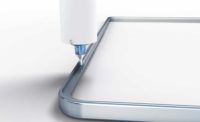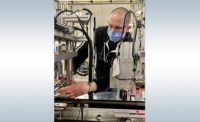1 // LASER-ACTIVATED PROCESS SEALS MOBILE DEVICES
Manz has developed a method for sealing displays on smartphones, smartwatches and fitness trackers. After the electronics and battery are assembled, a laser activates an adhesive on the device housing, which is then pressed onto the display glass. The process creates a dust-tight and watertight seal.
Cycle time can be as short as 3 seconds. Up to three machines can run in parallel and be loaded in an alternating sequence. Parts can be set up in trays and placed in the machine by a robot.
The machine can seal a range of display geometries and sizes. An inspection system records quality data, such as how much pressure was used to apply the glass onto the housing.
2 // ADHESIVE BONDS BATTERY PACKS
Henkel and Covestro have developed a method for securing lithium-ion battery cells inside a plastic holder. The method consists of a UV-curing acrylic adhesive and a UV-transparent polycarbonate blend.
Henkel’s Loctite AA 3963 adhesive was formulated to adhere strongly to Covestro’s Bayblend FR3040 mix of polycarbonate and ABS. The adhesive was formulated for long open times, short curing times and high-speed dispensing. The flame-retardant plastic can be molded as thin as 1 millimeter.
3 // ‘HYPER GLUE’ BONDS PLASTICS, FIBERS
Researchers at the University of British Columbia have developed an adhesive that promises to improve assembly of medical implants, body armor and other products. The researchers’ “hyper glue” bonds plastics and synthetic fibers at the molecular level in a process called cross-linking. The cross-linking takes effect when the adhesive is exposed to heat or long-wave UV light, making strong connections that resist impacts and corrosion. The adhesive is particularly effective for bonding high-density polyethylene.
4 // Researchers Toughen Adhesives
Make adhesives tougher by making them weaker. That’s the paradoxical idea proposed by researchers at Purdue University.
To make an adhesive tougher, the researchers added bonds that are broken easily throughout the material. When stress is applied to the adhesive, these sacrificial bonds absorb energy and break apart while the larger adhesive system remains intact.
“The idea is similar to how a brick wall is made of bricks that are offset from each other,” says Jonathan Wilker, a professor of chemistry and materials engineering at Purdue. “You stagger the bricks so that a crack does not shoot right down through the [mortar].”
5 // $82.4 BILLION
Global sales of adhesives and sealants will total $82.4 billion by 2025, according to Grand View Research. The market is expected to grow at a cumulative annual rate of 5.6 percent over the next five years.







